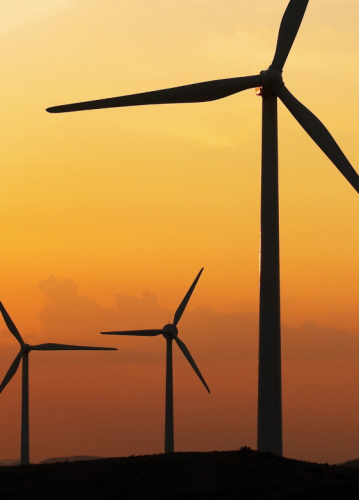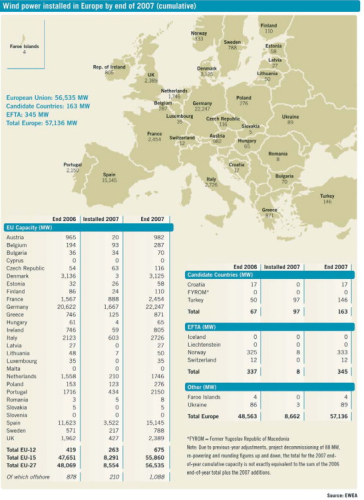

The USA continues to lead as the biggest annual market with over 5.2 GW of new wind power installations in 2007, expanding the nation's total wind power generating capacity by 45% in a single calendar year, notes the GWEC. It was followed by Spain and China, which added 3.5 GW and 3.4 GW to their total capacity respectively.
With the total installed capacity in the USA now standing at 16.8 GW, it can be expected that the country will overtake Germany as the largest market for wind energy by the end of 2009, provided that growth continues at the current rate.
According to the American Wind Energy Association (AWEA), new wind projects account for about 30% of the entire new power-producing capacity added nationally in 2007 and will power the equivalent of 1.5 million American households annually.
“This is the third consecutive year of record-setting growth, establishing wind power as one of the largest sources of new electricity supply for the country,” says AWEA's Executive Director, Randall Swisher. “This remarkable and accelerating growth is driven by strong demand, favourable economics, and a period of welcome relief from the on-again, off-again, boom-and-bust, cycle of the federal production tax credit (PTC) for wind power.”
“But the PTC and tax incentives for other renewable energy sources are now in danger of lapsing at the end of this year – and at the worst moment for the US economy,” he warns. “The US wind industry calls on Congress and the President to quickly extend the PTC – the only existing US incentive for wind power – in order to sustain this remarkable growth along with the manufacturing jobs, fresh economic opportunities, and reduction of global warming pollution that it provides.”
The US wind power network now provides 16 818 MW and spans 34 states. American wind farms will generate an estimated 48 billion kilowatt-hours (kWh) of wind energy in 2008, just over 1% of US electricity supply, powering the equivalent of over 4.5 million homes.
The AWEA's initial estimates indicate that this year could equal 2007 in terms of new wind capacity installed. Developers report that with strong demand for wind power across the country, wind turbines are sold out for the year. However, AWEA projects that with more companies entering the market, more turbines will become available. The pace of growth in 2008 and beyond is expected to largely depend, not on turbine availability, but on the timing and duration of an extension of the federal production tax credit.
At least 14 new manufacturing facilities opened or were announced in 2007, according to initial AWEA estimates. Companies are opening new manufacturing plants and expanding existing ones, creating new jobs and business opportunities across the country, even in states that do not have a large wind resource.
GE Energy continued to lead in wind turbine sales, with 45% of the market in terms of new capacity installed. FPL Energy remained top the list of wind project developers, with 956 MW of new development in 2007 alone.
Asia
The growth in Asia's markets has also been rapid, and over a quarter of all new capacity in 2007 was installed on the Asian continent. In China, over to 3.4 GW of wind energy capacity was added in 2007, bringing total installed capacity to 6 GW. This represents an increase of 156% compared with the wind capacity installed during 2006 and a 134% increase of the total installations.
"The growing wind power market in China has also encouraged domestic production of wind turbines, and we now have more than 40 domestic companies involved in manufacturing," according to Li Junfeng, Secretary General of the Chinese Renewable Energy Industry Association. "In 2007, domestic products accounted for 56% of the annual market, compared to 41% in 2006.”
India also continues to see a steady growth and now counts about 8 GW of wind power installations, up from just over 6.2 GW in 2006.
Europe
In 2007 wind capacity grew more in Europe than any other power-generating technology, an increase driven by Spain, according to statistics just released by the European Wind Energy Association (EWEA).
The installed capacity of wind power in Europe increased by 18% last year to reach a level of 56 535 MW. Despite this, some European Union (EU) countries did not grow as expected.
The total capacity of new wind turbines brought on line across the EU last year was 8554 MW, an increase of 935 MW on the 2006 total. Total wind power capacity installed by the end of 2007 will avoid about 90 million tonnes of carbon dioxide (CO2) annually and produce 119 Terawatt hours in an average wind year, equal to 3.7% of EU power demand. In 2000, less than 0.9% of EU electricity demand was met by wind power.
“It is positive that wind energy is now increasing more than any other power technology in Europe," comments Christian Kjaer, EWEA Chief Executive. "The market is up by 12% compared to 2006 but if we exclude Spain from the figures, the European market for wind turbines shows a small decline.”
Spain set a new record in 2007, installing 3522 MW – the highest amount of any European country in any year ever. 10% of its electricity now comes from wind. There was also sustained growth in France – which added 888 MW to reach 2454 MW – and Italy, with 603 MW more and a total of 2726 MW.
The new Member States performed well and increased installed capacity by 60%, with Poland, the most successful, reaching a total of 276 MW. The Czech Republic installed 63 MW, its best year ever, and Bulgaria 34 MW.
Nevertheless, a handful of markets pulled in the opposite direction including Germany, Portugal and the UK. As a result, the overall market growth in 2007 – 12% – was not as striking as it could have been. The global market for wind turbines grew by approximately 30% last year to 20 000 MW, and European companies continue to lead the market which is estimated to have been worth some €25 billion in 2007.
The change of pace in some countries can be explained by a mixture of slow administrative processes, problems with grid access and legislative uncertainty.
“Spain – like Germany and Denmark before her – has taken the lead. There is no doubt in my mind that a swift approval by the 27 Member States and the European Parliament of the Commission's proposed renewable energy directive would pave the way for an equally massive expansion of wind energy in other Member States”, comments Kjaer.
Wind power continued to be one of the most popular electricity generating technologies in the EU in 2007, making up 40% of total new power installations. Since 2000, the EU has installed 158 000 MW of new power capacity. New gas installations totalled 88 000 MW; wind energy 47 000 MW; coal 9600 MW; oil 4200 MW; hydro 3100 MW; biomass 1700 MW; and nuclear 1200 MW over the eight-year period, according to figures from Platts PowerVision and EWEA.
Rest of world
After some slow years, the Pacific market experienced new impetus in 2007, especially in New Zealand, where 151 MW were installed in 2007. In Australia, the newly elected Labour government has ratified the Kyoto Protocol and pledged to introduce a 20% target for renewable energy by 2020, justifying an optimistic outlook for future wind energy developments.
Competitive
“Emissions-free wind power can be brought on line quickly, and must play a major role in meeting climate protection targets," says Steve Sawyer, Secretary General of GWEC."This is especially the case in the critical period between now and 2020 when greenhouse gas emissions must peak and begin to decline if we are to avoid the worst impacts of climate change.”
Wind energy has now become an important player in the world's energy markets. In terms of economic value, the global wind market is estimated to be worth about €25 billion or US$36 billion per year in new generating equipment.
“Wind power is increasingly economically competitive with conventional sources of electricity," says GWEC's Chairman, Professor Arthouros Zervos. "Increasing volatility in fossil fuel prices and increased concerns about energy security mean that wind power is often the most attractive option for new generation capacity, from any point of view.”


